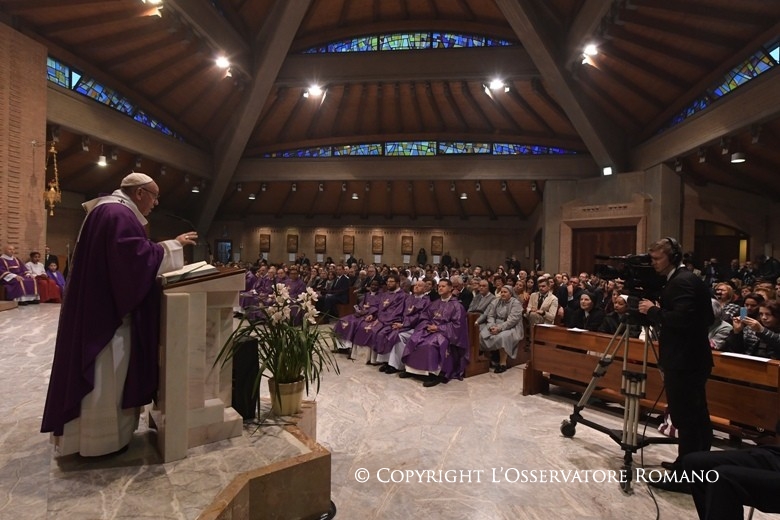Sunday afternoon, March 12, 2017, the Second Sunday of Lent, the Holy Father Francis went on a pastoral visit to the parish of Santa Maddalena di Canossa, in the Ottavia suburb of Rome.
Upon his arrival, around 3:50 p.m., the Pope met with children and catechism youngsters in the parish sports field. Then, the Holy Father greeted the elderly and the sick in the crypt and, in the parish theater, he met with spouses who baptized their children in 2016. In addition, he greeted briefly the ministers, the priests of the 36th Prefecture, which belongs to the parish, and some Sisters Daughters of Charity (Canossians), accompanied by their Superior General. Finally, the Holy Father heard the confession of some penitents.
At 6:00 p.m., he presided over the Holy Mass in the parish church. After the proclamation of the Gospel, the Pope gave an off-the-cuff homily. At the end of the visit, the Holy Father returned to the Vatican around 7:45 p.m.
Here is a Zenit working translation of the homily during the Mass:
***
The Holy Father’s Homily
In this passage of the Gospel (cf. Matthew 17:1-9) reference is made twice to the beauty of Jesus, of Jesus-God, of luminous Jesus, of Jesus full of joy and of life. First, in the vision: “He was transfigured.” He was transfigured in front of them, the disciples: “His face shone like the sun, and His garments became white as light.”
And Jesus is transformed, is transfigured. The second time, while they were coming down from the mountain, Jesus commanded them not to speak of this vision before He had risen from the dead, that is, in the Resurrection Jesus will have – He had had, but at the moment He had not yet risen – the same luminous, brilliant face, it will be like that! But what did He wish to say? That between this transfiguration, so beautiful, and the Resurrection, there would be another face of Jesus: there will be a not so beautiful face; there will be a awful face, disfigured, tortured, scorned, bloodied by the crown of thorns . . . Jesus’ whole body in fact will be something to discard — two transfigurations and in between Jesus Crucified, the Cross. We must look at the Cross a lot! It is Jesus-God — “this is my Son,” “this is my Son, the Beloved!” –, Jesus, the Son of God, God Himself, in whom the Father is well pleased: He annihilated Himself to save us! And to use a very strong, a very strong word, perhaps one of the strongest words of the New Testament, a word that Paul uses: He was made sin (cf. 2 Corinthians 5:21). Sin is the most awful thing; sin is an offense to God, a slap to God, it’s to say to God: “ I don’t care about you, I prefer this . . . ‘ And Jesus was made sin, He annihilated Himself, He lowered Himself to this . . . And to prepare the disciples not to be scandalized to see Him like this, on the Cross, He underwent this transfiguration.
We are used to talking about sins: when we go to Confession – “I did this sin, I did that other . . . –; and also in Confession, when we are forgiven, we feel we are forgiven because He has taken this sin in the Passion: He became sin. We are used to talking about others’ sins. It’s an awful thing . . . Instead of talking about others’ sins, I don’t say we make ourselves sin, because we can’t, but <we must> look at our sins and <look> at Him, who became sin. This is the path to Easter, to the Resurrection: to go ahead with the certainty of this transfiguration; to see this most luminous, most beautiful face, which will be the same in the Resurrection and the same we will see in Heaven, and also to see this other face, which was made sin; He paid in this way for all of us. Jesus was made sin, He was made God’s malediction for us: in the Passion the blessed Son became the accursed, because He took our sins upon Himself (cf. Galatians 3:10-14). Let us think of this – so much love! So much love! And let us think also of the beauty of the transfigured face of Jesus that we will see in Heaven.
And may this contemplation of the two faces of Jesus – the transfigured and the one made sin, accursed – encourage us to go ahead on the path of life, on the path of Christian life. May it encourage us to ask for forgiveness of our sins, not to sin so much . . . May it encourage us especially to have confidence, because if He became sin it is because He took our sins upon Himself. And He is always willing to forgive us. We must only ask for it.
[Original text: Italian] [Translation by Virginia M. Forrester]

Pope's Homily at Roman Parish of Santa Maddalena di Canossa
‘And may this contemplation of the two faces of Jesus – the transfigured and the one made sin, accursed – encourage us to go ahead on the path of life, on the path of Christian life.’


